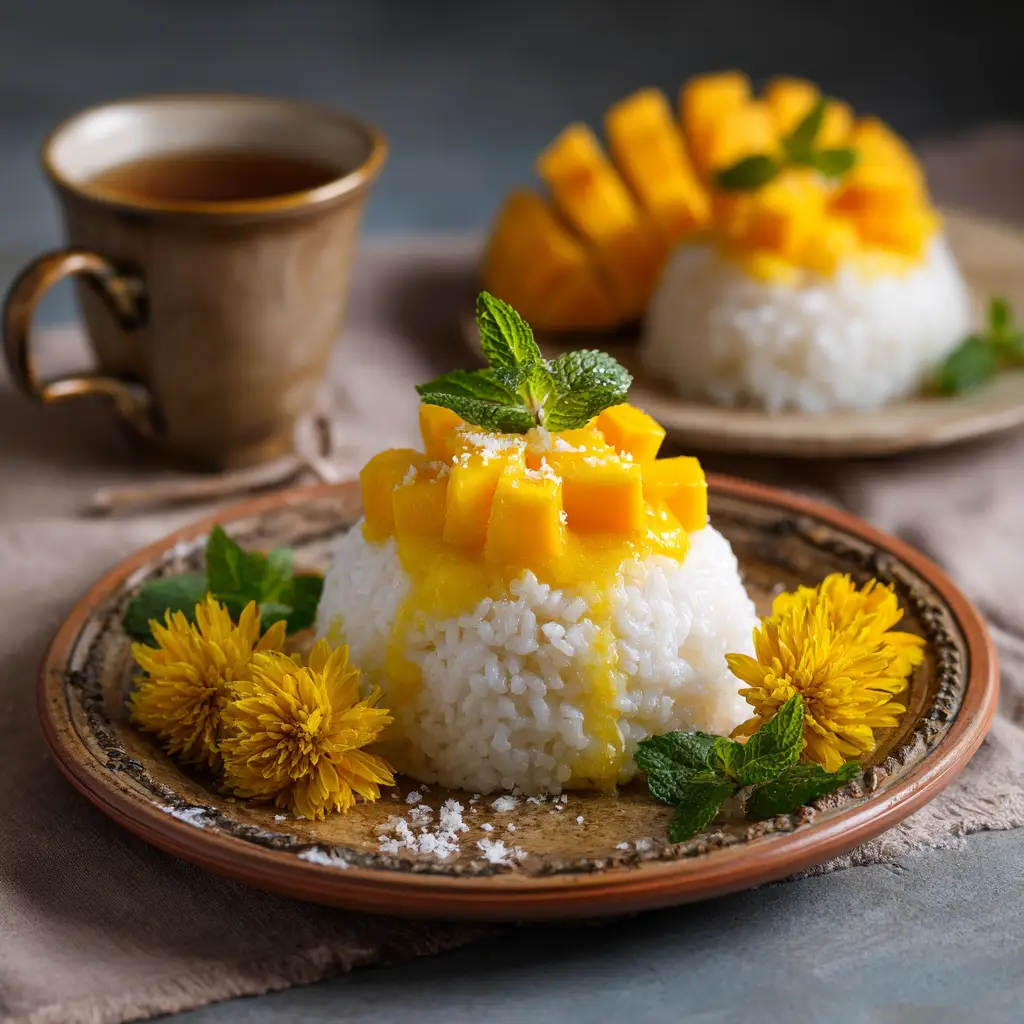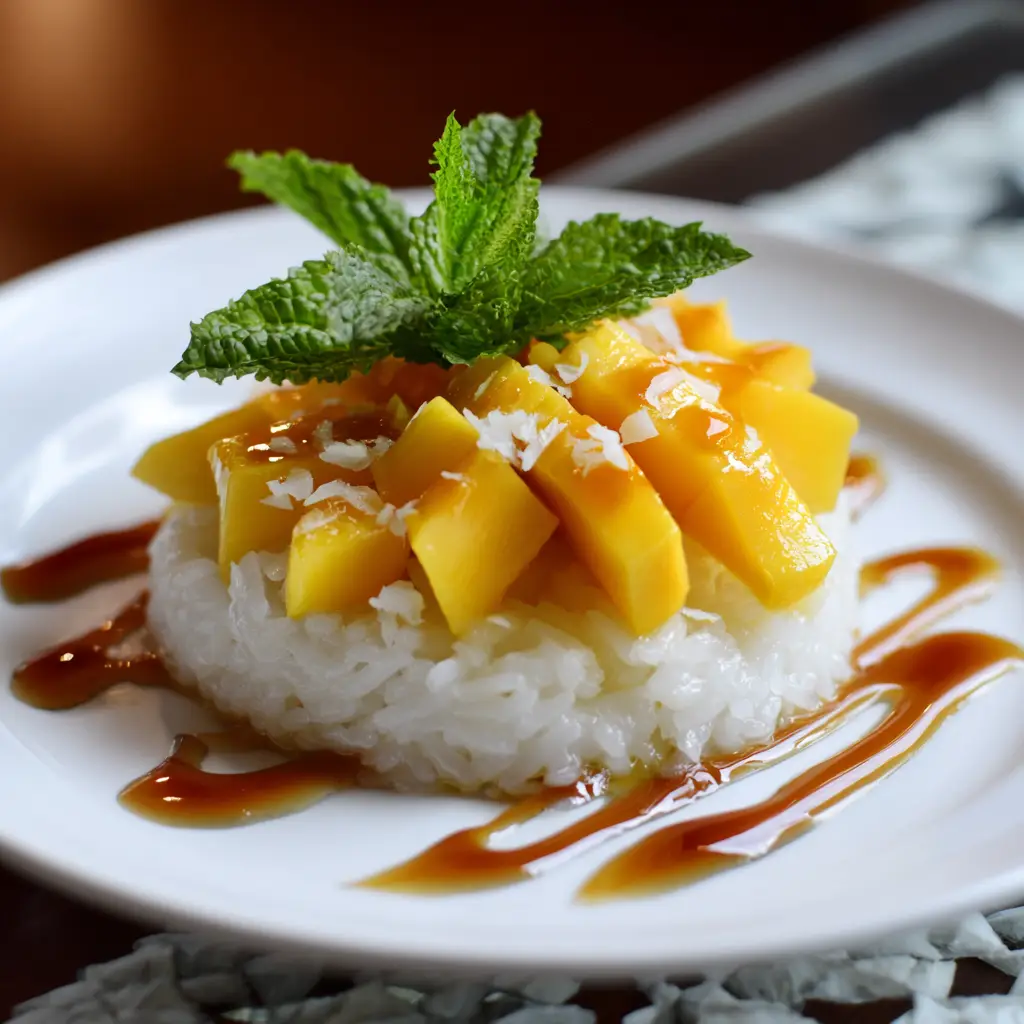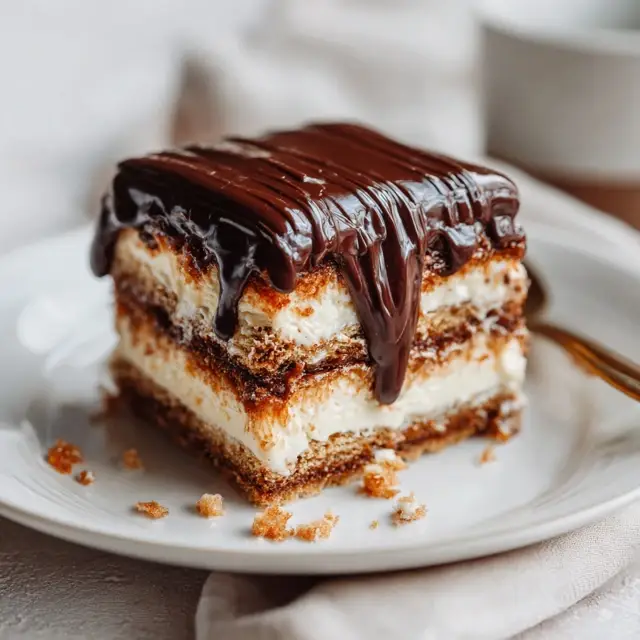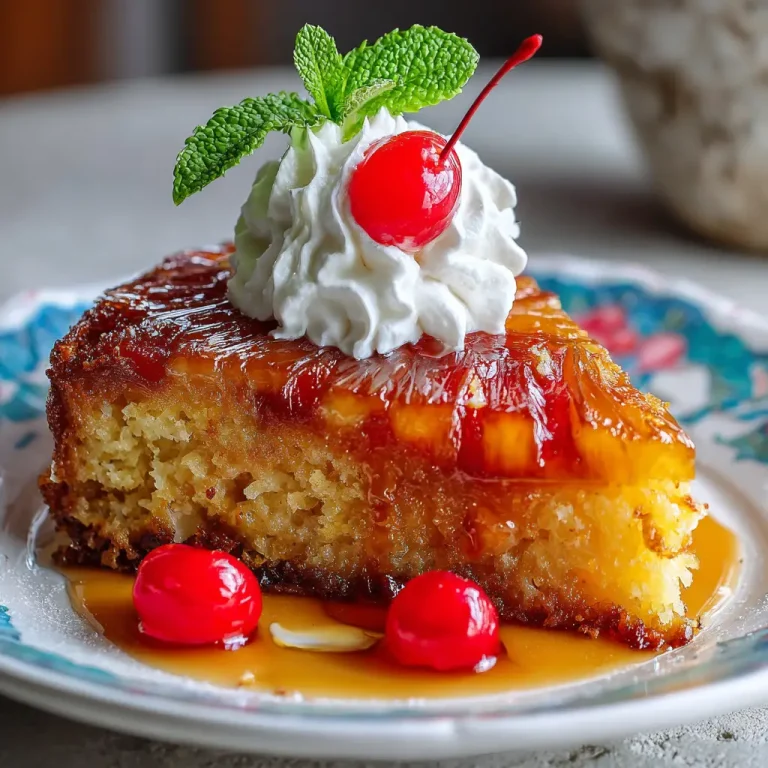Mango Sticky Rice Recipe – Authentic Thai Dessert with Coconut and Fresh Mango
Warm summer evenings often call for something sweet, tropical, and satisfying. Few dishes meet those cravings quite like mango sticky rice, Thailand’s beloved dessert that has now found a home in kitchens around the globe. The combination of fragrant sticky rice soaked in rich coconut milk and topped with ripe, juicy mango slices creates a balance that’s both indulgent and refreshing.

Mango sticky rice isn’t just a treat; it’s an experience. It’s the kind of dish that evokes memories of street markets in Chiang Mai or the warm hospitality of a Thai household. It’s simple, but every component plays an essential role in creating that perfect bite. What makes it even more lovable is its adaptability. With just a few ingredients and a bit of patience, this dessert can easily be recreated at home.
Whether you’re new to Thai cuisine or a longtime fan, making mango sticky rice in your own kitchen is not only rewarding but also surprisingly straightforward. You don’t need a chef’s resume or expensive tools—just a love for food and a desire to explore something timelessly delicious.
Ingredients Needed
Before diving into the recipe, it’s important to gather the right ingredients. Freshness matters here, especially when it comes to the mangoes and coconut milk. Here’s a detailed list of everything you’ll need, along with the approximate calorie count per serving.
| Ingredient | Quantity | Calories (approx) |
|---|---|---|
| Glutinous (sticky) rice | 1 cup (uncooked) | 640 |
| Coconut milk | 1 cup | 445 |
| White sugar | 1/4 cup | 200 |
| Salt | 1/4 teaspoon | 0 |
| Ripe mangoes | 2 medium | 270 |
| Mung beans (optional) | 2 tablespoons | 100 |
| Pandan leaf (optional) | 1 leaf | 0 |
Total per serving (based on 4 servings): Around 415–450 calories
Step-by-Step Cooking Instructions
Creating mango sticky rice is a joyful process. It’s not complicated, but timing and technique make a difference. Follow these steps to make the perfect version at home.
1. Soak the sticky rice
Start by rinsing the sticky rice thoroughly under cold water. Rinse several times until the water runs clear. Then, soak the rice in water for at least 4 hours or overnight for best results.
2. Steam the rice
Drain the soaked rice. Set up a steamer lined with cheesecloth or a clean kitchen towel. Add the rice and steam over boiling water for about 25 to 30 minutes. The rice should be tender but not mushy. If using a bamboo steamer, place a banana leaf under the rice for extra aroma.
3. Prepare the coconut sauce
While the rice is steaming, heat the coconut milk in a small saucepan over medium heat. Add sugar and salt. Stir until fully dissolved. Do not let it boil. Once the mixture is smooth and fragrant, remove from heat.“For a perfect dessert pairing, try our Mango Sticky Rice alongside the rich and gooey Mix Brownies Casserole.”
4. Combine the rice and coconut milk
Once the sticky rice is cooked, transfer it to a large mixing bowl. Slowly pour about two-thirds of the coconut milk mixture over the rice while it’s still hot. Gently mix it together without smashing the grains. Let it rest for 15 to 20 minutes so the rice can absorb the sweet coconut milk.
5. Make the topping sauce
Take the remaining third of the coconut milk mixture and return it to the heat. Stir constantly until it thickens slightly. You can add a cornstarch slurry (1 teaspoon cornstarch mixed with 1 tablespoon water) if a thicker consistency is preferred. Set aside for drizzling.
6. Toast the mung beans (optional)
In a dry pan over low heat, toast the mung beans until golden and crispy. These will add a lovely crunch on top.
7. Assemble and serve
Peel and slice the mangoes just before serving. On a plate, place a mound of coconut-infused sticky rice. Arrange mango slices alongside. Drizzle the thick coconut topping over the rice and sprinkle with toasted mung beans for texture.

Tips for Customizing the Recipe
While the traditional version is hard to beat, it’s also fun to explore variations to suit different tastes or dietary needs.
Use brown sticky rice
For a nuttier flavor and a boost in fiber, try using brown glutinous rice. It will have a chewier texture but still absorb coconut milk beautifully.
Switch up the fruit
Mangoes are the star, but don’t be afraid to experiment. Try fresh lychee, grilled pineapple, or even strawberries when mangoes are out of season.
Go dairy-free and vegan
Traditional recipes are already dairy-free, but ensure your sugar is vegan-friendly if you’re serving to someone with strict dietary restrictions.
Add pandan flavor
Boil a pandan leaf with the coconut milk for an aromatic twist. It adds a floral, vanilla-like aroma that’s distinct and widely loved in Southeast Asian desserts.
Reduce sugar for a lighter dessert
Simply cut down the sugar in the coconut milk mixture if you prefer a less sweet version. The natural sugars from ripe mangoes may be enough.

Nutritional Information
Mango sticky rice is rich, creamy, and satisfying. While it may not be the lightest dessert, it does offer a mix of nutrients, especially when using high-quality, whole ingredients.
Per Serving (approximate):
It’s worth noting that most of the fat comes from coconut milk, which is high in saturated fats. If you’re watching your intake, use light coconut milk or simply reduce the quantity.
Serving Suggestions
Presentation matters, especially with a dish as visually appealing as this. Here’s how to make it shine on the table:
- Use a banana leaf or a decorative plate to serve for a traditional Thai look
- Garnish with sesame seeds or mint leaves for an added touch of elegance
- Serve slightly warm rice with chilled mango slices for a contrast in temperature
- Pair it with Thai iced tea or jasmine green tea for a full dessert experience
- Make mini portions for party platters or as part of a Thai-themed dinner
Mango Sticky Rice Recipe – Authentic Thai Dessert with Coconut and Fresh Mango
Course: Blog4
servings10
minutes35
minutes420
kcalIngredients
IngredienttQuantity
Glutinous (sticky) ricet1 cup (uncooked)
Coconut milkt1 cup
White sugart1/4 cup
Saltt1/4 teaspoon
Ripe mangoest2 medium
Mung beans (optional)t2 tablespoons
Directions
- ctions
- Soak the rice: Rinse sticky rice until water runs clear, then soak in water for at least 4 hours or overnight.
- Steam the rice: Drain the rice and steam over boiling water for 25–30 minutes until tender.
- Prepare coconut sauce: Heat coconut milk, sugar, and salt in a saucepan over medium heat. Stir until dissolved, but do not boil. Remove from heat.
Recipe Video
Notes
- Use ripe, sweet mangoes like Ataulfo or Nam Dok Mai for best flavor.
Soaking the sticky rice overnight ensures perfect texture.
Avoid regular rice; glutinous rice is essential for authentic sticky texture.
Frequently Asked Questions
Can I make mango sticky rice ahead of time?
Yes, you can prepare the sticky rice and coconut sauce a day in advance. Store separately in airtight containers in the fridge. Reheat the rice gently by steaming or microwaving with a splash of water before serving.
What kind of mangoes are best for this recipe?
Use ripe, sweet mangoes like Ataulfo, Nam Dok Mai, or Alphonso. These varieties are soft, fragrant, and naturally sweet, which complements the sticky rice beautifully.
Is it okay to use regular rice?
Sticky rice is essential for the authentic texture and taste. Regular white or jasmine rice won’t absorb the coconut milk in the same way and may result in a mushy consistency.
How long does sticky rice last in the fridge?
Cooked sticky rice can be stored in the fridge for up to three days. Keep it covered tightly to avoid drying out. Reheat gently before serving.
Can I freeze mango sticky rice?
It’s not recommended. The texture of the sticky rice and mango changes significantly after freezing. For best results, enjoy it fresh or within a day or two.
Conclusion
Creating mango sticky rice at home is more than just cooking—it’s a celebration of flavor, culture, and simplicity. Every spoonful offers a little escape, a mini-vacation to the vibrant streets of Thailand. With ripe mangoes, creamy coconut milk, and perfectly steamed sticky rice, you’re not just making dessert—you’re crafting a timeless classic.







